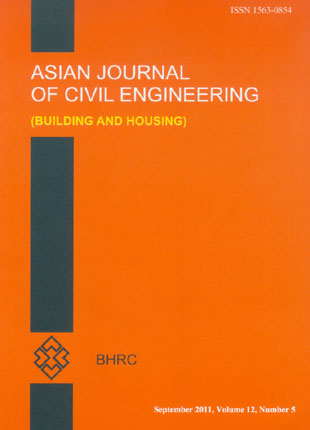فهرست مطالب

Asian journal of civil engineering
Volume:12 Issue: 5, Sep 2011
- تاریخ انتشار: 1389/12/25
- تعداد عناوین: 8
-
-
Page 551This study addresses the application of polypropylene (PP) nonwoven layers forstrengthening cement composite by investigating its flexural performance. Nonwoven layers produced by two different bonding techniques (needle-punching and calendaring) were used to reinforce cement sheets. The effect of some parameters related to layers on cement reinforcement was considered in this study. In addition, the application of short fibers (PP and acrylic) on cement/nonwoven composites was experienced. It was found that the cement composite made of thinner layers exhibits greater load-bearing capacity, because of the better penetration of the cement paste to nonwoven layers. The cement matrixes reinforced by nonwoven layers showed better flexural performance and strain-hardening behaviour compared to short fibers reinforced cement composites.
-
Page 563Utilization of industrial soil waste or secondary materials has encouraged in constructionfield for the production of cement and concrete because it contribute to reducing theconsumption of natural resources. Copper slag is one of the materials that is considered as a waste which could have a promising future in construction Industry as partial or fullsubstitute of either cement or aggregates. Many researchers have already found it possible to use copper slag as a concrete aggregate. But not much research has been carried out in India concerning durability and corrosion studies of copper slag admixed concrete. This paper presents the results of an experimental study on various corrosion and durability tests on concrete containing copper slag as partial replacement of sand and cement. For this research work, M20 grade concrete was used and tests were conducted for various proportions of copper slag replacement with sand of 0 to 60%, cement of 0 to 20% in concrete. The obtained results were compared with those of control concrete made with ordinary Portland cement and sand.
-
Page 579This article provides a comparison process on how to calculate seismic forces by the staticanalysis method stated both in the international Building Code (IBC) 2003 and in the Iranian Seismic Code (IS 2800-05). The seismic coefficient for the equivalent lateral force is specified by the following factors: fundamental period, importance factor, spectral response acceleration, and building response modification factor. In this article the above-mentioned parameters are obtained through the IBC 2003 and are compared against those covered in the IS 2800-05. Studies and comparison of factors would lead to significant differences in the results obtained using the two codes. In order to clarify the problem, design base shear of a building with combined system (special moment steel frames + eccentric bracings) in four different soil types and vertical distribution of base shear at story level is obtained, in accordance with both codes; and the results are compared with diagrams and tables. The results prove the need to review the IS 2800-05 and develop more appropriate relations towards achieving economic and functional objectives
-
Page 597The purpose of this experimental investigation is to study the behavior of short columnsproduced from High Performance Concrete (HPC). In this investigation HPC was manufactured by usual ingredients such as cement, fine aggregate, coarse aggregate, water and mineral admixtures such as Silica Fume (SF) and Fly ash at various replacement levels and the Super Plasticizer used was CERAPLAST-300. The water binder ratio (w/b) adopted is 0.30. The concrete used in this investigation was proportioned to target a mean strength of 60 MPa. Specimens such as cubes, cylinders and prism beams were cast and tested for various mixes viz. Seven mixes M1 to M7 are cast with 0%, 5%, 7.5% and 10% replacement of SF and another set of specimens with 0%, 5%, 7.5% and 10% replacement of SF along with 10% constant replacement of Fly ash to study the mechanical properties such as compressive strength, split tensile strength and flexural strength at different ages of concrete such as 3, 7, 28, 56 and 90 days. The result shows that the optimum replacement of silica fume is 7.5%. If 10% of Fly ash is added the optimum replacement of silica fume is 5%. Totally 7 columns were cast for mixes M1 to M7. The column specimens were tested in 1000kN loading frame at 28 days. From this, Load-Mid height deflection (P-Δ) curves were drawn and compared. The same failedcolumns were rehabilitated with GFRP sheets with one or two layers and again tested in1000kN loading frame. The results were then compared with the initial results.
-
New Probabilistic Approach for Liquefaction Resistance of Sand-Silt Mixtures Using Laboratory-Based Shear Wave VelocityPage 619
-
Page 637In this paper, semi-active response control of tall buildings equipped with magnetorheological dampers is studied. Clipped-optimal control algorithm based on linear quadratic regulator (LQR) is employed for semi-active controller design. Bouc-Wenphenomenological model is utilized to investigate the nonlinear behavior of the MRdampers. The performance of the resulting control system is compared to the ncontrolledstructure for a benchmark building through simulation, and the efficiency of using MRdampers is evaluated.
-
Page 651Euler-Bernoulli beam model based non-local elasticity theory is developed for the staticand buckling analysis of cantilever carbon nanotubes (CNTs). The size effect is takeninto consideration using the Eringen’s non-local elasticity theory. The derivation ofgoverning equation of bending and buckling from the shear and moment resultants of thebeam and stress-strain relationship of the one-dimensional non-local elasticity model ispresented. Buckling and deflection values of CNTs are obtained and presented ingraphical form. Numerical results are presented to show the small-scale effect onbending of CNTs.
-
Page 663During this year, 150 earthquakes with magnitude greater than 4 occurred in Iran. Inaddition; more than 331 accelerograms were recorded by the accelerographs of the IranStrong Motion Network, operated by the Building and Housing Research Center. Amongthese, the Qeshm Island earthquake of 10th Sep. 2008, with Mw6.1 was the greatest one.The main shock of this earthquake triggered 11 accelerographs. Its maximum PGA wasabout 597 Cm/s/s that were registered by Tomban Station. The strong motion andseismological data of important accelerograms are listed in the appendix table.


